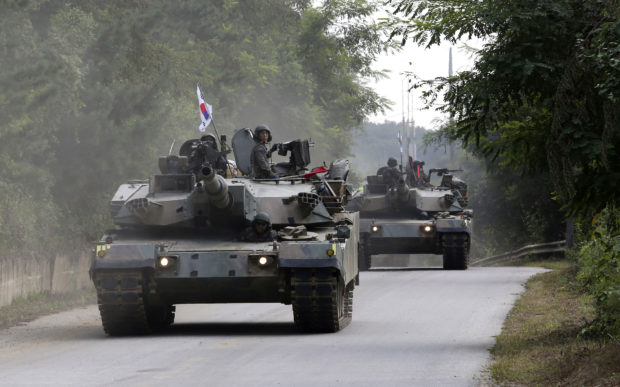N. Korea cloud has silver lining for South’s armsmakers

South Korean army’s K-1 tanks move during a military exercise in Paju, South Korea, near the border with North Korea, Monday, Sept. 4, 2017. Following U.S. warnings to North Korea of a “massive military response,” South Korea’s military on Monday fired missiles into the sea to simulate an attack on the North’s main nuclear test site a day after Pyongyang detonated its largest ever nuclear test explosion. (AP file photo/Ahn Young-joon)
The constant missile and nuclear threats from South Korea’s belligerent northern neighbor have racked regional tensions sky-high, but they are a boon for the country’s burgeoning defense industry.
South Korea has been one of the world’s largest importers of military equipment and technology for decades—mostly from the US—but in recent years its domestic sector has grown rapidly.
Arms exports have soared tenfold in a decade, from just $253 million in 2006 to $2.5 billion last year, according to government data.
The country’s missiles, howitzers, submarines and warplanes are especially popular in Southeast Asia, Eastern Europe and South America.
Once a largely agricultural backwater devastated by war, South Korea now has companies that have become world leaders in fields ranging from shipbuilding to smartphones, and its arms manufacturers are starting to follow suit.
Analysts say having nuclear-armed North Korea on its doorstep has focused international military attention on Seoul’s forces and the equipment they use.
“Its military is well-respected, because of Korea’s difficult strategic situation—it faces one of the most dangerous threats in the world, and the military is well-trained to cope with it,” said Richard Aboulafia, an analyst with Teal Group, an aviation and defense consulting firm.
“Thus, weapons choices made by the military are very well respected.”
For now, said Aboulafia, South Korean systems are lower-end than their US or European competitors—but also cheaper.
Showpiece weapon
Advanced locally produced weapons were on show at this week’s Seoul International Aerospace and Defense Exhibition, with organizers saying it was aimed at showcasing South Korean arms manufacturers, rather than giving foreign suppliers a shop window as in the past.
Exhibitors included some familiar Korean names, with Hyundai’s defense subsidiary displaying armored vehicles and wearable robots, and its Kia Motors unit—known for compact, affordable family cars—offering light tactical vehicles.
A security arm of Hanwha Group, most recognizable in insurance and hotels, showed off a large unmanned ground vehicle.
Other homegrown fare included the K2 tank, K9 self-propelled artillery and the Surion utility helicopter.
South Korea’s showpiece weapon is the T-50, a supersonic advanced trainer jet jointly built by state-run Korea Aerospace Industries (KAI) and Lockheed Martin of the US, which also comes in a light combat version.
Some 60 T-50s have been exported to countries including Thailand, Indonesia, Iraq and the Philippines in sales worth over $2.3 billion in the last decade, and KAI is in talks with potential buyers in Africa and Latin America.
“Ten years ago, people refused to board South Korean aircraft, saying that they didn’t want to be guinea pigs,” KAI’s international marketing chief Choi Sang-Yeol said, noting that attitudes had changed significantly.
KAI is seeking a $15 billion deal with the US military to replace 350 ageing American training jets with the T-50, although it faces fierce competition from Boeing and its partner Saab.
If secured, the deal would be the South’s biggest-ever military sale and open up more markets, Choi said.
Golden Eagle
A US T-50 sale could see South Korea’s defense exports reach as much as $12 billion in 2017, the Korea Institute for Industrial Economics & Trade said in a recent report.
Left-leaning new President Moon Jae-In is an enthusiastic supporter, posing in a T-50 cockpit and telling the arms fair’s opening ceremony: “Our defense industry must take the leap from being a local producer of advanced weapons to become an export industry.”
In the face of the North Korean threat, the proportion of government spending that Seoul devotes to defense is among the world’s highest outside Middle East and African conflict zones, according to 2016 figures from the Stockholm International Peace Research Institute.
At 12.5 percent of the national budget, it is ahead of the 9.3 percent of the US, even though on the campaign trail President Donald Trump called on South Korea to spend more.
Organizers forecast some $800 million of export deals would be agreed during the arms fair.
But there is a downside to the peninsula’s tensions.
Aircraft acquisitions entail decades of after-sales service, and buyers want to be sure that suppliers will be in existence to provide it.
“Stability is key,” said KAI’s Choi. “I get questions about what will happen if a war breaks out and about the company’s long-term commitment.” /jpv